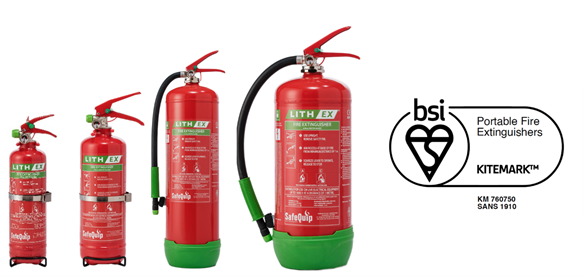SafeQuip, a leading distributor of fire safety solutions, puts compliance at the heart of everything it does, ensuring every extinguisher performs when it matters most.

SafeQuip provides a full range of SABS-certified fire extinguishers for homes, workshops, the factory floor, and other applications.
Why compliance matters
South Africa has clear fire safety regulations, and for good reason. Lives depend on them. According to SANS 10400-T, all fire extinguishers installed in buildings must meet the requirements set out in SANS 1910. The Pressure Equipment Regulations also make it illegal to use extinguishers that have not been manufactured or filled according to these standards.
Not every extinguisher in the market – or installed – meets these standards. SafeQuip warns that some suppliers cut corners to save costs. They might use inferior powder, skip safety components or place a fake approval label on a cylinder that has not been appropriately certified. From the outside, the layperson would not necessarily know. That’s what makes the equipment risky.
What to check
There are a few key things property owners, facilities managers, and plant operators should always check to ensure their fire extinguishers are compliant with the national standards.
- Certification marks: Only SABS, BSI (Kite Mark), or SACAS can certify extinguishers under SANS 1910. If the label does not show one of these certifications, it should not be trusted.
- Powder quality: The extinguisher must contain SANS 1522-certified dry chemical powder. Anything less is a risk.
- Cylinder stamps: Every extinguisher must be permanently marked with the standard, the manufacturer’s name, date, test pressure, and serial number.
- Label details: Customers should look for the manufacturer’s information, as well as working pressure, weight, fire rating, and hydrostatic test pressure. If anything is missing, the equipment is not compliant.
- Valve check: The valve must include a safety pressure relief device and CE marking. Customers should ask for the module certificate.
Servicing and reconditioning
Servicing is another area to monitor. Fire extinguishers must be serviced to the original specifications by SANS 1475-certified companies, and by SAQCC-registered technicians. Some service companies may replace the original manufacturer’s instruction label with a fake label, which would make the unit non-compliant if the company’s name is not on the manufacturer’s certification schedule.
Choosing reliable equipment
When lives, livelihoods, and legal liabilities are at stake, the details matter. Next time you walk past that red canister on the wall, ask yourself: is it up to standard? If it’s not, it might not be there when you need it most.
SafeQuip provides a full range of SABS-certified fire extinguishers, for homes, workshops, the factory floor, and other applications. Its stored pressure dry chemical powder (DCP) extinguishers are built to handle Class A, B, and C fires. And because not all fire risks are the same, SafeQuip offers different powder grades to match the level of hazard in a given environment.
The SANS 1910:2022 approved, Lith-Ex fire extinguisher range, from SafeQuip, carries NTA 8133:2021 (KIWA/POOO55865) test approval, which confirms its lithium-ion battery fire extinguishing capability.
The company also supplies high-performance CO₂ extinguishers for electrical and flammable liquid fires, as well as specialised units like wet chemical and foam extinguishers. All products are built for easy maintenance to SANS 1475 standards by SAQCC-qualified technicians. A full range of accessories and spares ensures complete fire protection from installation to servicing.
For more information visit: www.safequip.co.za